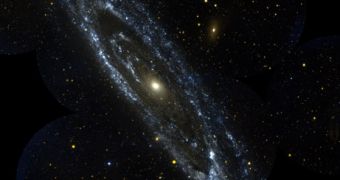The discovery of a new fast moving dwarf galaxy, named Andromeda XIV, which seems to orbit our closest spiral galaxy, Andromeda, also known as M31 amongst astronomers, questions again the scientists' calculations regarding the mass of M31, and may provide new information about the nature of such rogue galaxies and their role in galaxy formation.
The dwarf is only the latest of recent discoveries of small galaxies present in the so-called local group, which includes our Milky Way and M31, but unlike most of the other dwarf galaxies that are tied to larger galaxies by gravitational fields, Andromeda XIV seems to be a satellite that has a rather fast orbit around M31, suggesting that the larger galaxy is much more massive that astronomers previously thought. Or maybe the dwarf galaxy is just passing through the local group in its path through space.
If indeed the fast moving galaxy has just arrived in the galactic neighborhood, that means that the formation of the local group is not yet finished since we are still picking up new galaxies coming from outside the group. Observations on the newly discovered galaxy suggest that it hasn't been affected by the gravitational tides of neighboring galaxies over long periods of time.
Similar to the dwarf stars, dwarf galaxies get their name from the fact that they are relatively small compared to other galaxies, and contain only a few billions stars. They usually have spheroidal or elliptical shapes, and scientists believe that they could be composed entirely out of the elusive dark matter, which hasn't been yet observed, but could account for the extra gravitational pull exerted on the galaxies that compose the visible universe. Calculations show that about 25 percent of the matter present in the visible universe must be dark matter in order for the galaxies to keep their shape.
The light coming from the dwarf galaxy helped astronomers estimate the amount of dark matter present in its composition. They believe that about 99.5 percent of its mass is dark matter, the rest being represented by light. Dwarf galaxies should be quite common in the universe, even though they are extremely difficult to observe due to the low amount of light they give off.
Due to their sizes, astronomers believe that they are actually the basic building block of bigger galaxies, such as spiral galaxies, that form through a process of matter accretion, visible in the observations of the distant universe; however, it is currently unknown the rate at which this process is taking place today, since there is no direct evidence of the infalling occurring in the local group. However, it is believed that more that 20 dwarf galaxies might exist in the orbit of the Milky Way, or the M31.
Though the spheroidal dwarf galaxies do not present evidence of actively producing stars, or presence of gas, the theory still suggests that they are participating in the formation of larger spiral galaxies, by falling into them to share their gas content by blowing up the older stars to produce new ones. According to astronomer Daniel Zucker, from the University of Cambridge, England, Andromeda XIV is not the only new arriving galaxy in the local group.

 14 DAY TRIAL //
14 DAY TRIAL //